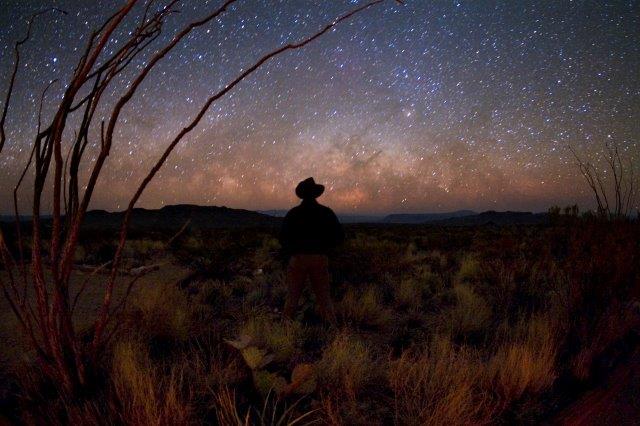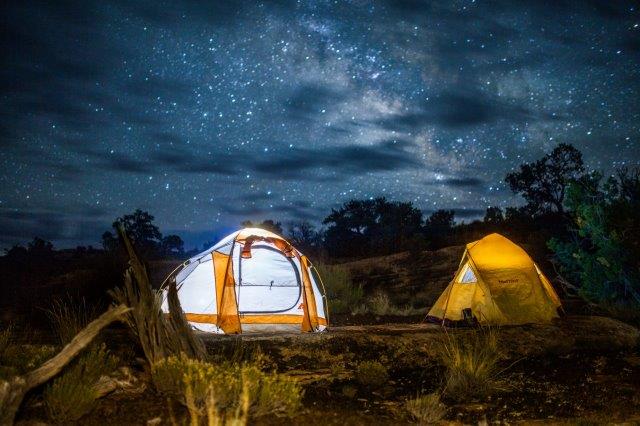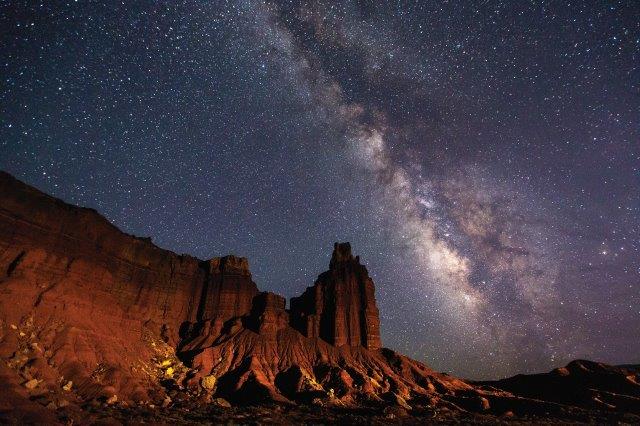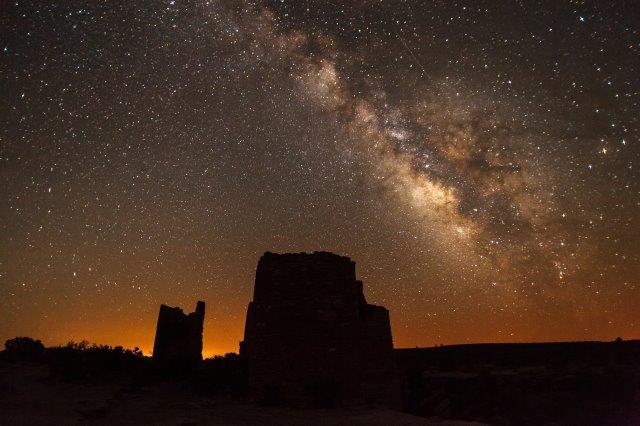I admire those who can point to the dark night sky and identify a slew of constellations. Growing up as a fourth generation inner-city Chicagoan, looking up at the sky to see the stars wasn’t exactly one my pastimes. Yes, there were school trips and family trips to Adler Planetarium, but the sky was always flooded in light. Stargazing wasn’t something I considered until I started traveling.
Take a look at this dark sky map.
Today, my repertoire of constellations is still small. But I love my laminated sky chart and my Sky Map phone app, and make a point to enjoy some of the bigger sky events. Viewing the Perseids meteor showers is something I look forward to each year, for example.

Big Bend International Dark Sky Park, in Texas (Photo by Tyler Nordgren.)
Enjoying the Night Sky
So far, I’ve experienced spectacular night skies only a handful of times: in northern Wisconsin and Minnesota; in Saskatchewan and British Columbia, Canada; from the roof a houseboat on Shasta Lake in California; from outside a cabin in Eastern Oregon, and from the Sahara Dessert in Morocco. Each time elicited one of those moments when everything just seemed to stop and my heart sang. They’re memorable moments; moments when I felt freed of everyday concerns, and awe of and connected with the natural world. I look forward to seeking out more experiences like these.

Canyonlands National Park, an International Dark Sky Park in Utah. (Photo by Emily Ogden.)
The International Dark Sky Association
I spoke with Cheryl Ann Bishop, Communications and Public Affairs Director with the International Dark Sky Association (IDA) about their work, and the benefits of travelers seeking out and experiencing the dark night sky.
Confetti Travel Café (CTC): How did the International Dark Sky Association begin?
International Dark Sky Association (IDA): Light pollution has long been a concern of astronomers–professional and amateur alike–but before IDA, there was no organization dedicated to addressing this problem. IDA was founded in 1988 by two astronomers, one a professional and the other an amateur. Originally, the main concern for IDA was mitigating light pollution to benefit astronomers and stargazers. Since then, IDA’s mission has greatly expanded to include the protection of wildlife, ecosystems, and human health and safety, from the harmful effects of artificial light at night.
“Astro-tourism is on the rise and isn’t just amateur astronomy; it’s also about simply experiencing the night sky…most people have to travel to get that experience.”
– Cheryl Ann Bishop, IDA
CTC: You’ve had success working with Florida on night lighting to protect sea turtles and with improved night lighting fixtures. People care about issues when they have some amount of direct experience. How do you work to educate organizations and government entities, as well as the general public?
IDA: We only have a staff of five full-time people, so a lot of our public outreach work is done through volunteer members of our more than 50 chapters across the globe.
CTC: What’s the process of receiving a Dark Sky designation or certification with you? What’s advantage to these places to go through the process?
IDA: Our International Dark Sky Places (IDSPs) conservation program was created to recognize excellent stewardship of the night sky. Designations are based on stringent outdoor lighting standards and innovative community outreach. Our Dark Sky Places set examples on how to mitigate light pollution and educate the public at the same time.
The first designation was made in 2001–the City of Flagstaff, Arizona, as an International Dark Sky Community. The work to obtain a designation can take several years depending on the site and usually requires collaboration with public officials and area businesses and communities.
Since the program began, we’ve designated 71 International Dark Sky Places in 15 different countries across six continents. This includes 41 Dark Sky Parks, 11 Dark Sky Reserves, 14 Dark Sky Communities, two Dark Sky Sanctuaries and three Developments of Distinction.
We’re really proud that our IDSPs continue to set examples worldwide for excellence in night sky stewardship and public education. Many of our Dark Sky Parks saw significant increases in visitation last year related to their night skies programming.
A Dark Sky designation has the potential to transform parks and their surrounding communities by attracting recognition, acclaim and economic benefits. In fact, a recent study found that communities near Dark Sky Places do reap financially rewards. Several of our IDSPs have received significant funding to expand their dark sky programming including building onsite observatories.

Capitol Reef National Park, an International Dark Sky Park in Utah. (Photo by Jacob W. Frank.)
Astro-Tourism: Experiencing the Dark Night Sky
CTC: What are the benefits for us as individuals of experiencing the dark night sky?
IDA: When we experience a dark sky, we often feel awe, inspiration as well as humility. It gives a sense of our place in the universe and connects us to our ancestors who experienced the same night skies. Dark night skies have inspired art, poetry as well as innovation, such as learning to navigate the waters of the globe using the night sky.
CTC: Traveling to see the Aurora Borealis (Northern Lights) and Aurora Australis (Southern Lights) are very popular right now. But it seems the tourism industry (and travel writers) are missing the opportunity to promote the dark skies in their areas. Observatories often hold star gazing events, but what would you like to see to broaden star gazing as an experience for everyone? There’s appeal here for all ages, families, couples, and individuals.
IDA: We would definitely love to see more people be able to experience a dark night sky. Unfortunately, many people live in areas that are polluted with light. In fact, a recent study determined that more than 80 percent of the world’s population lives under light polluted skies. The United States and Europe have it even worse, with 99 percent of their residents experiencing sky glow at night. This is why our International Dark Sky Places program, which designates Dark Sky Places, is so important and why we want it to continue to expand. The program not only helps protect the night skies of the designated areas, it also has a public outreach element. Achieving a designation requires implementing night sky programming that includes education about the importance of dark skies and negative impacts of light pollution.
One thing we have noticed is that astro-tourism is on the rise and isn’t just about amateur astronomy anymore; it’s also becoming about simply experiencing the night sky. We regularly hear from people about their experience of awe and humility at seeing a natural night sky for the first time. Now, most people have to travel to get that experience. The rapid growth of our Dark Sky Places program and subsequent media coverage, and increasing awareness about light pollution and the importance of dark skies are also helping to fuel the industry.

Hovenweep National Park, an International Dark Sky Park in New Mexico. (Photo by Jacob W. Frank.)
Efforts to Preserve the Night Sky
CTC: How do renewable energy sources, water conservation and other environmental improvements fit into the picture of the work you do?
IDA: We estimate that about 30 percent of all outdoor lighting in the United Sates alone is wasted, most due to lights that aren’t shielded. That adds up to $3.3 billion and the release of 21 million tons of carbon dioxide per year. To offset all that carbon dioxide, we’d have to plant 875 million trees annually. Ensuring that all outdoor lighting is shielded saves energy and helps mitigate climate change.
Plants and animals depend on Earth’s daily cycle of light and dark rhythm to govern life-sustaining behaviors. Research shows that artificial light at night has negative and deadly effects on many species.
We’re still learning about the negative effects of light pollution on wildlife, but it is clear that has detrimental effects on certain animal species of mammals, birds, amphibians, reptiles and insects. And it’s not just those near urban areas. Sky glow can light up rural areas and block the moon and stars from view negatively affecting nocturnal animals.
CTC: What are some things we as individuals can do?
IDA: The good news is that this is a really easy problem to solve. The first thing people can do to help fight light pollution is do a home outdoor lighting audit and make sure that all their outdoor lighting is shielded so that the light shines down on the ground where it’s needed and not up into the sky. We also recommend that people turn their outdoor lights off at night. If security lighting is necessary, motion sensor lighting is best. Next, people can contact their local government officials to talk about the importance of dark sky friendly lighting. We have lots of resources that people can use. Many municipalities have passed lighting ordinances after citizens came together and demanded it.
CTC: What are a few of your favorite night sky experiences?
IDA: I used to live on Orcas Island in the San Juan Island in northwest Washington State. I remember several nights standing in a saltwater bay filled with bioluminescence—algae that emit a glow—and looking up at the dark night sky. It was so beautiful and surreal. But the darkest night sky I’ve ever seen was in central Vermont. There were some many stars crammed against each other that it was difficult to identify the constellations. It was a sea of white. Absolutely incredible!
CTC: Thanks so much for all your time, Cheryl Ann!
The Take Away: Look Up
Take a look at the International Dark Sky Association’s website. Consider getting involved, either with the IDA or on a local level in your own hometown. Consider making a donation to help further their work. Take a look at your own outdoor lighting. Turn off lights or use timers, indoors and out, when not in use. Visit an observatory and learn more about the night sky.
Take a look at the IDA’s online resources below, and find optimum places to view the dark sky. Visit a Dark Sky Park, or another location that has dark sky programming.
However you do it, make the effort to get out of town, away from the city lights, then look up—and enjoy!
For More:
- International Dark Sky Association: https://darksky.org/
- Find a Dark Sky Place:https://darksky.org/idsp/finder/
- A great interactive map lets you see where the darkest areas are, as well as the areas with the most light pollution: https://www.lightpollutionmap.info/
- IDA study: https://darksky.org/80-of-world-population-lives-under-skyglow-new-study-finds/
- Friends of the Goldendale Observatory YouTube video: https://www.youtube.com/watch?v=x-Gxd2rlUG0
-Photos with permission and courtesy of the International Dark Sky Association. Cover photo: Snowdonia International Dark Sky Research in Wales, Photo by Kris Williams via Flick CC 2.0


